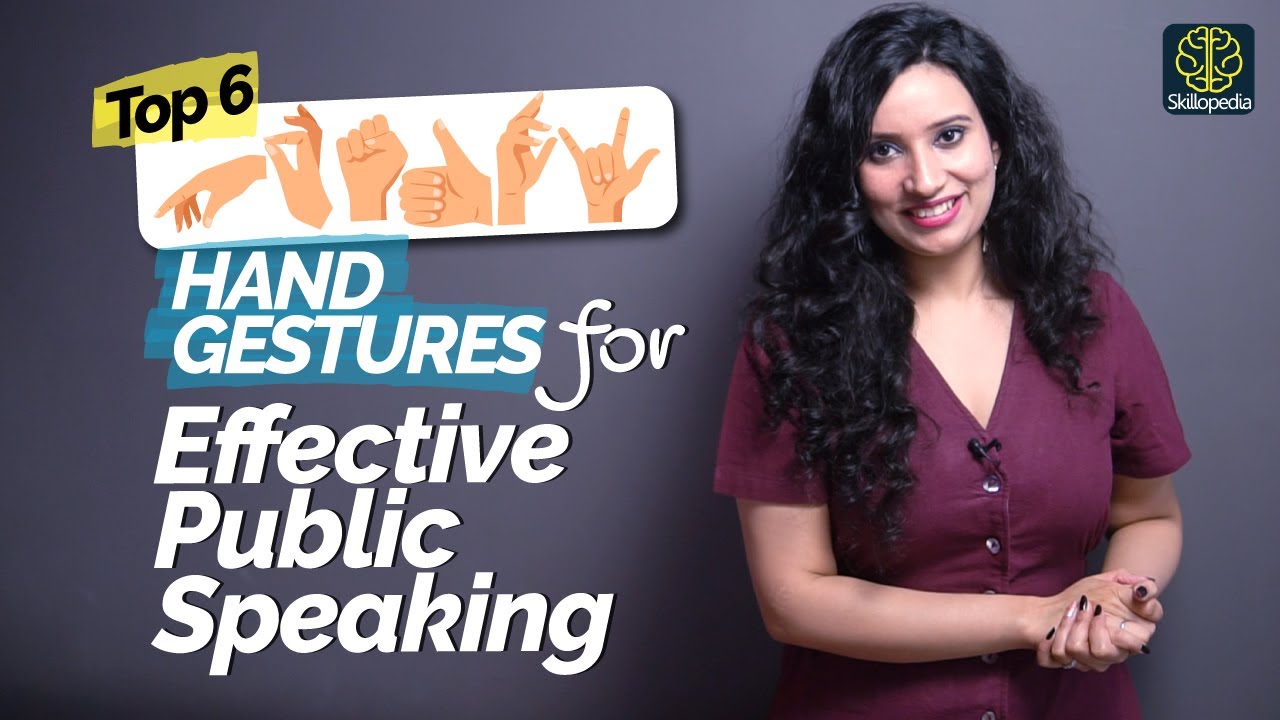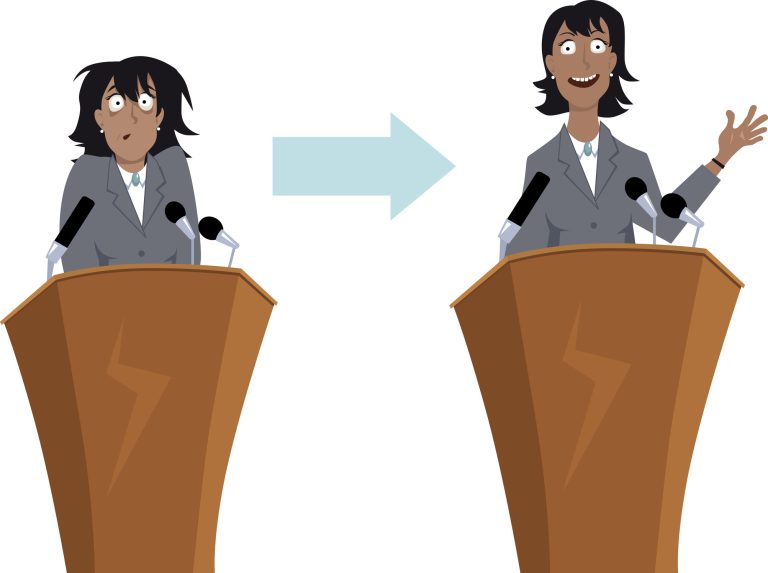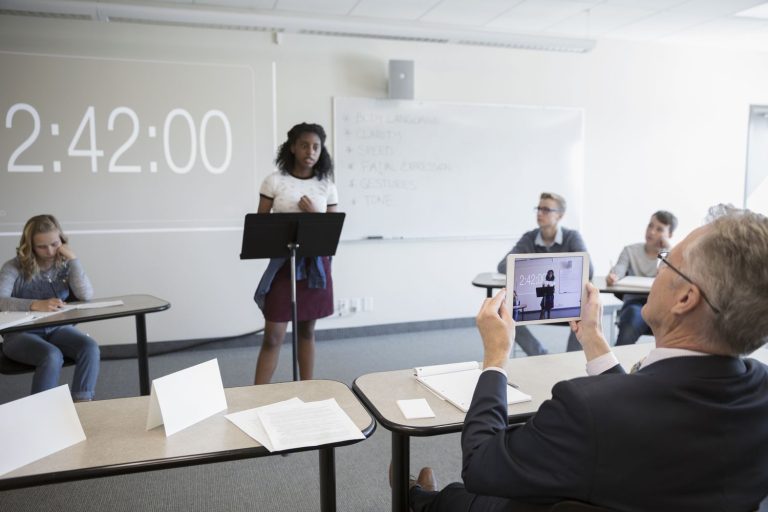Gestures in Public Speaking
Gestures in public speaking enhance communication effectiveness by adding visual and non-verbal cues to the speaker’s message. In addition to spoken words, the speaker’s body language, facial expressions, and hand movements can greatly impact the audience’s understanding and engagement.
These gestures serve to emphasize key points, convey emotions, and establish rapport with the audience. Through strategic use of gestures, a speaker can effectively convey confidence, credibility, and authenticity, thereby making their message more persuasive and memorable. By incorporating appropriate gestures into their delivery, public speakers can enhance their overall performance and create a stronger connection with their audience.
Emblems: Nonverbal Gestures With Specific Meanings
Discover the power and impact of nonverbal gestures in public speaking. Emblems serve as concise and meaningful nonverbal cues with specific meanings, enhancing communication effectiveness. Mastering these gestures can greatly elevate your public speaking skills.
Gestures play an integral role in public speaking, allowing speakers to convey their message beyond words. One category of gestures, known as emblems, consists of nonverbal signals that possess specific meanings. Understanding these emblematic gestures can help speakers effectively engage with their audience and communicate their ideas.
Let’s explore some examples of emblematic gestures and their associated meanings:
Thumbs Up:
- Indicates approval or agreement with a particular idea or statement.
- Can be used to signal affirmation, encouragement, or support.
Peace Sign:
- Symbolizes peace, harmony, or unity.
- Often used to advocate for nonviolence or as a gesture of goodwill.
Ok Sign:
- Forms an “O” shape with the thumb and index finger.
- Represents approval, agreement, or understanding.
- Can also indicate that everything is going well.
A-Ok Gesture:
- Similar to the OK sign but with the thumb, index finger, and middle finger forming an “A” shape.
- Indicates that everything is perfect or going smoothly.
Crossed Fingers:
- Involves crossing the index and middle fingers.
- Typically used to wish for luck or to express hope that something will happen as desired.
Applause:
- Clapping hands together to show appreciation or approval.
- Often used to acknowledge a speaker’s accomplishment or to express agreement with their statements.
Pointing Finger:
- Directing attention towards something specific.
- Signals emphasis or draws focus to a particular point or element.
Nodding:
- Moving the head up and down slightly.
- Demonstrates agreement, understanding, or acknowledgement of a speaker’s point.
Shushing Gesture:
- Placing the index finger over the lips.
- Indicates a request for silence or a reminder to keep noise levels down.
Victory Sign:
- Forming a “V” shape with the index and middle fingers.
- Traditionally associated with victory or triumph, it can also symbolize peace or represent a victory gesture.
Emblematic gestures provide valuable nonverbal cues that enhance public speaking presentations. By effectively utilizing these gestures, speakers can engage their audience, emphasize key points, and convey specific meanings without uttering a word.
Illustrators: Gestures That Accompany And Enhance Verbal Messages
Illustrators use gestures to complement and enhance verbal messages in public speaking. These gestures not only add depth and meaning to the speech but also captivate the audience, making the presentation more engaging and memorable.
Gestures In Public Speaking:
Engaging your audience and effectively conveying your message in public speaking goes beyond the words you speak. Gestures play a crucial role in enhancing your verbal messages, making them more impactful and memorable. In this section, we will delve into the importance of illustrators, gestures that accompany and enhance your storytelling and reinforce key points in a public speaking setting.
Enhancing Storytelling:
Using illustrators, or gestures that depict the actions and events in a story, can significantly enhance your storytelling abilities. By incorporating appropriate gestures, you can transport your audience into the narrative, making it more engaging and vivid. Here are some ways gestures can enhance your storytelling:
- Physicality: Use your body language to visually depict characters, settings, and actions, bringing the story to life before your audience’s eyes. For example, use hand gestures to imitate a character’s movement or utilize facial expressions to convey emotions.
- Timing: Properly timed gestures can effectively emphasize critical moments in your story, creating suspense or highlighting significant events. For instance, pause before executing a gesture to build anticipation, and then make the gesture with conviction to capture your audience’s attention.
- Spatial awareness: Utilize spatial gestures to enhance the audience’s understanding of the story’s physical environment. Use your hands to create imaginary objects or draw ‘invisible’ lines in the air to represent boundaries, sizes, or distances.
Reinforcing Key Points:
In addition to enhancing storytelling, gestures can also reinforce key points in your speech, making them more memorable. By complementing your verbal messages with corresponding gestures, you can effectively emphasize important information or arguments. Here are some ways gestures can reinforce key points:
- Emphasis: Use gestures to amplify the impact of important words or phrases in your speech. By incorporating a forceful hand gesture or emphasizing a particular movement, you can add weight and significance to your message, ensuring it resonates with your audience.
- Visualization: Gestures can help create visual representations of abstract concepts or complex ideas, making them more accessible to your audience. For example, you can gesture to demonstrate size comparisons, show cause-and-effect relationships, or illustrate the progression of a process.
- Engagement: Involving your audience through gestures can increase their engagement and active participation. Encourage interaction by inviting the audience to mirror your gestures or prompting them to respond physically to certain cues. This not only reinforces your key points but also fosters a deeper connection with your listeners.
Incorporating illustrators and utilizing gestures that accompany and enhance your verbal messages can significantly elevate your effectiveness as a public speaker. By incorporating storytelling-enhancing gestures and reinforcing key points through well-timed and meaningful movements, you can captivate your audience, leaving a lasting impression.
Regulators: Gestures That Control The Flow Of Conversation
Public speaking is greatly influenced by gestures that regulate the flow of conversation. These nonverbal cues aid in effective communication and captivate audiences, making the message more impactful.
Gestures In Public Speaking:
Keeping the audience engaged:
- Eye contact: Maintain eye contact with different members of the audience to create a connection and show that you value their presence.
- Facial expressions: Use facial expressions to convey emotions and add emphasis to your message. Smiling, raising your eyebrows, or furrowing your brow can help captivate the audience.
- Head nods: Nodding your head occasionally shows agreement, understanding, or approval, encouraging the audience to remain attentive.
- Hand gestures: Utilize hand gestures to emphasize key points or add visual interest. Pointing, counting with your fingers, or making sweeping motions can enhance comprehension.
- Body movement: Move around the stage or designated speaking area to keep the audience visually engaged. However, be mindful not to overdo it and distract from your message.
Managing turn-taking:
- Raising the hand: Encourage the audience to participate by raising their hands to ask questions or provide input.
- Pauses: Use deliberate pauses to allow the audience to process information and formulate their thoughts before engaging in discussions.
- Nodding and eye contact: While listening to the audience, nod and make eye contact to indicate that you are actively involved in the conversation.
- Open gestures: Adopt an open posture, with your arms uncrossed and facing forward, to signal approachability and promote open dialogue.
- Recap and summarize: Provide recaps or summaries of key points throughout your presentation to ensure that everyone is on the same page.
By incorporating these gestures and techniques, you can effectively regulate the flow of conversation during public speaking engagements. Remember, maintaining audience engagement and managing turn-taking are crucial for a successful and interactive presentation.
Adaptors: Unconscious Gestures That Serve Personal Needs
Discover the power of unconscious gestures in public speaking with ‘Adaptors: Unconscious Gestures that Serve Personal Needs. ‘ Explore how these subtle cues can shape communication and engage your audience effectively. Master the art of nonverbal communication and leave a lasting impact.
Gestures play a crucial role in public speaking, allowing speakers to communicate effectively and engage their audience. Among the various types of gestures, adaptors are especially intriguing as they are unconscious movements that serve personal needs. In this section, we will explore two common adaptors: scratching the head and tapping the foot, and understand their significance in public speaking.
Scratching The Head:
- When a speaker scratches their head during a presentation, it may signify confusion or uncertainty.
- This gesture can also indicate that the speaker is deep in thought, trying to recall or process information.
- Scratching the head can be perceived as a sign of nervousness or anxiety, possibly reflecting the speaker’s discomfort in front of an audience.
- It is essential for speakers to be aware of this gesture, as excessive or constant head scratching can distract the audience from the message being delivered.
Tapping The Foot:
- Tapping the foot is another common adaptor observed during public speaking, often indicating restlessness or impatience.
- This gesture could suggest that the speaker is eager to move forward or wrap up the presentation.
- Foot tapping may also signify nervousness, as the speaker unconsciously tries to release built-up tension.
- Although tapping the foot can be distracting for the audience, speakers may be able to control this habit through self-awareness and practice.
Understanding adaptors like scratching the head and tapping the foot can provide insights into a speaker’s mindset during a presentation. By recognizing and managing these unconscious gestures, speakers can deliver their message more effectively and engage their audience without unnecessary distractions.
Remember, public speaking is not only about words but also about nonverbal cues that contribute to a powerful and memorable presentation.
Nonverbal Synchronization: Aligning Gestures With Speech
Aligning gestures with speech is crucial in public speaking. Nonverbal synchronization enhances communication, creating a powerful and persuasive message. Mastering gestures can captivate the audience and convey confidence and authenticity.
In public speaking, nonverbal communication plays a crucial role in enhancing the effectiveness of your message. Gestures, when synchronized with speech, can significantly impact your delivery and help you connect with your audience on a deeper level. By aligning your gestures with your words, you can convey your message more convincingly and make a lasting impression.
Let’s explore two key aspects of nonverbal synchronization: timing and coordination, as well as naturalness and authenticity.
Timing And Coordination
- Gesture timing: Timing your gestures properly can amplify the impact of your speech. Here’s how timing and coordination can enhance your delivery:
- Use gestures to punctuate important points: By synchronizing gestures with key words or phrases, you can emphasize their significance and ensure they are memorable to your audience.
- Avoid excessive or delayed gestures: Overusing or untimely gestures can distract and confuse your listeners. It is important to maintain a balance and ensure your gestures align harmoniously with your speech.
Naturalness And Authenticity
- Reflecting authenticity: When delivering a speech, it is crucial to appear genuine and authentic. Here’s how aligning gestures with speech can enhance your naturalness:
- Use gestures that match your personality: Your gestures should reflect your natural style to establish a connection with your audience. Trying to imitate someone else’s gestures may come across as artificial and insincere.
- Avoid forced or exaggerated gestures: Forced gestures can be a distraction and undermine your authenticity. It’s important to maintain a natural and comfortable level of movement that complements your speech.
By understanding the significance of nonverbal synchronization, specifically the aspects of timing and coordination, as well as naturalness and authenticity, you can elevate your public speaking skills. Practice aligning your gestures with your speech to create a more impactful and engaging delivery.
Remember, the power of nonverbal communication lies in its ability to convey messages beyond words.
Balance And Moderation: Using Gestures Sparingly And Appropriately
Balance and moderation are key in utilizing gestures effectively in public speaking. By using gestures sparingly and appropriately, speakers can enhance their message and engage their audience without overwhelming or distracting them.
Effective public speaking goes beyond the words spoken. It involves utilizing gestures to enhance communication and connect with your audience on a deeper level. However, it is essential to strike a balance and use gestures sparingly and appropriately. By avoiding excessive movements and adapting gestures to the audience, you can effectively engage and convey your message.
Avoiding Excessive Movements:
- Limit repetitive gestures: Avoid excessive repetition of the same gestures, as this can be distracting and take away from the message. Varying your gestures helps keep your audience engaged.
- Maintain control: While it’s natural to use body movements to express yourself, be mindful of the intensity. Wild and uncontrolled gestures can overshadow your speech and make it difficult for your listeners to focus.
- Stay relaxed: If you feel tense or nervous, you may resort to excessive or erratic movements. Take deep breaths, maintain a calm posture, and try to be conscious of your gestures. Remember, moderation is key.
Adapting Gestures To The Audience:
- Consider cultural differences: Different cultures have distinct norms and meanings associated with gestures. Avoid gestures that may be offensive or misinterpreted in certain cultures. Researching cultural norms beforehand can help you adapt your gestures accordingly.
- Gauge audience response: Pay attention to how your audience responds to your gestures. If they seem engaged and receptive, continue with similar gestures. However, if your gestures elicit confusion or disinterest, consider adjusting your approach to better connect with your listeners.
- Mirror audience energy: Adapting your gestures to match the energy and dynamics of your audience can create rapport and enhance understanding. If the audience is more laid-back, using calm and subtle gestures can be effective. On the other hand, if the crowd is energetic and lively, incorporating more dynamic and expressive gestures can help captivate their attention.
Remember, gestures should enhance your message, not overshadow it. Practicing moderation in your gestures and adapting them to suit your audience will ensure effective communication and leave a lasting impression. So, practice and refine your gestures to strike the perfect balance in your public speaking engagements.
Practice And Rehearsal: Perfecting Gestures For Maximum Impact
Perfect your public speaking by practicing and rehearsing your gestures. Enhance your impact with carefully crafted movements for maximum audience engagement.
Gestures In Public Speaking:
Gestures play a crucial role in enhancing the impact of your public speaking. When used appropriately, gestures can add depth and clarity to your message, helping you connect with your audience on a deeper level. To ensure that your gestures are effective, it is essential to practice and rehearse them properly.
Here are some strategies you can use to perfect your gestures for maximum impact:
Mirror Exercises For Self-Awareness:
- Stand in front of a mirror and observe your natural gestures. Take note of any repetitive or distracting movements that may take away from your message.
- Practice using deliberate and purposeful gestures that align with your speech. Pay attention to your facial expressions, hand movements, and body posture while rehearsing.
Feedback From Trusted Individuals:
- Seek feedback from trusted friends, colleagues, or mentors who have experience in public speaking. Ask them to observe your gestures and provide constructive criticism.
- Request specific feedback on the clarity and effectiveness of your gestures and whether they enhance or distract from your message.
- Consider recording yourself during practice sessions to review your gestures objectively and identify areas for improvement.
Remember, the goal of practicing and rehearsing your gestures is to make them feel natural and seamless, rather than forced or exaggerated. By incorporating mirror exercises and seeking feedback, you can refine your gestures and ensure that they enhance your public speaking skills, leaving a lasting impact on your audience.

Credit: www.washingtonpost.com
Frequently Asked Questions For Gestures In Public Speaking
What Are Gestures In Public Speaking?
Gestures in public speaking refer to the movement of hands, arms, and body to convey meaning, emphasize points, and engage the audience. They can enhance the speaker’s communication, aid in conveying emotions, and make the presentation more dynamic and memorable.
Why Are Gestures Important In Public Speaking?
Gestures are important in public speaking because they help to convey non-verbal messages, create visual interest, and make the presentation more engaging. They can also help the speaker to establish credibility, connect with the audience, and enhance the overall delivery of the speech.
How Can I Use Gestures Effectively In Public Speaking?
To use gestures effectively in public speaking, it is important to practice and be mindful of your body language. Use natural and purposeful movements that align with your message. Avoid excessive or repetitive gestures, and make sure they are visible to the entire audience.
Gestures should be used to support and reinforce your spoken words.
What Are Some Common Gestures Used In Public Speaking?
Some common gestures used in public speaking include open palms to show openness, pointing to emphasize specific points, using hand movements to show size or quantity, and using sweeping motions to indicate the scope or importance of an idea. It’s important to use gestures that are authentic and natural to you.
Conclusion
Gestures are a crucial aspect of public speaking that can greatly enhance the impact of your message. They serve as powerful non-verbal cues that can captivate and engage your audience, making your presentation more dynamic and memorable. When used effectively, gestures can help convey emotions, emphasize key points, and add visual interest to your speech.
However, it’s important to use gestures in a natural and authentic way, ensuring they align with your words and intentions. Avoid excessive or unnecessary gestures that may distract or detract from your message. Instead, focus on purposeful movements that complement your speech and enhance your delivery.
Remember to practice and refine your gestures, as well as consider your body language and facial expressions as part of your overall presentation. By mastering the art of gestures, you can become a confident and persuasive public speaker, leaving a lasting impression on your audience.




